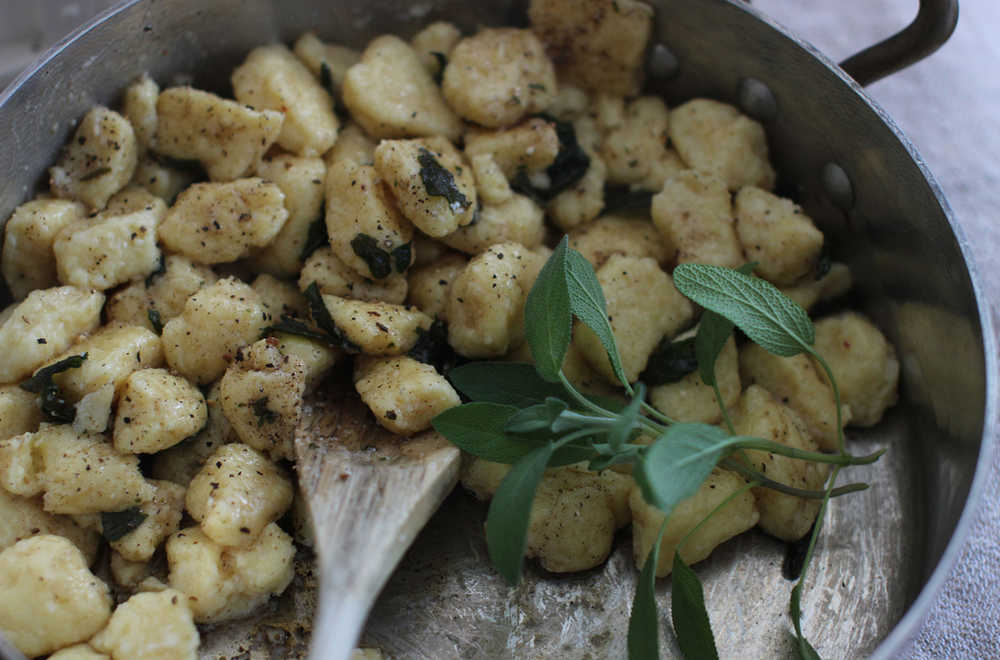MIAMI BEACH, Fla. — When Portland chef Jenn Louis set out to perfect pasta dumplings in Italy, she was occasionally met with such disdain from local chefs she might as well have been trying to push the doughy fare to the Paleo diet crowd.
“Each person I interviewed and cooked with had a different notion about what was and was not gnocchi. When I approached the subject as dumplings, I was quickly corrected and told that dumplings are Chinese food. (This was accompanied by a smirk and shake of the head in many cases.),” Louis writes in her new cookbook, “Pasta by Hand.”
After five years of research and two trips to Italy, Louis now is comfortable saying dumplings are pasta. And deliciously so.
And to make her point, she dedicated her entire cookbook to dumplings made from all manner of ingredients, including flour, potatoes, bread and semolina. Like so much Italian food, the rustic shapes and ingredients of the dumplings vary by region, from little nubs perfect for completing a vegetable soup to long, thin pencil-like dumplings paired with tomato sauce or a hearty ragu.
In the book, Louis’ dumplings are hand-formed doughy masses that can be poached, simmered or fried and often are stuffed with regional foods, such as creamy homemade ricotta, spinach, leftover pork sausage and even more exotic offerings such as chestnuts and wild nettles.
Many of the recipes were passed along to Louis as she cooked with locals and chefs at their homes and restaurants around Italy. Louis has been making pasta from scratch at her Lincoln Restaurant in Portland, Oregon, for years. But she says it still was fascinating to unearth recipes and techniques from small villages that few outsiders had ever tasted.
“They would be very, very uncomfortable letting me cook with them, and then they saw that I knew what I was doing and was very passionate about what they were teaching me and were like, ‘OK, let me show you something’,” Louis said during a recent interview with The Associated Press during the South Beach Wine and Food Festival.
Louis calls her dumplings weekend recipes, though there are plenty that aren’t labor intensive. And Louis points out that none requires a pasta maker. Some call for nothing more than a bowl and a spoon. Frascarelli is a good dumpling to make with children, made by drizzling water over semolina and using a bench scraper to turn the pasta over on itself, then shaking the sieve until you get nice, big chunks that are simmered in boiling water.
“It’s as simple as you can get. I think that some of these are incredibly rudimentary, some of the original pasta shapes,” she said.
As for the carb haters or gluten-free readers, she’s included dumplings made with chickpeas instead of flour, and Louis says gluten-free flour can be substituted in most of the dishes for traditional all-purpose. She rarely sits down to a big bowl of pasta herself, but does enjoy it for a side dish or a weekend splurge. There’s also several recipes with veggies, such as orecchiette with turnip greens, anchovies and garlic.
Jenn Louis says these light ricotta dumplings come from Italy’s Amalfi Coast and sometimes are made with lemon zest. “They are held together with as little flour as possible to keep their texture creamy and tender,” she writes in her new cookbook, “Pasta by Hand.” She says they are traditionally dressed with just butter or tomato sauce.
Start to finish: 30 minutes
Servings: 4
2 cups whole-milk ricotta cheese
6 egg yolks
1/2 cup grated Parmesan cheese
Freshly grated nutmeg
1 teaspoon kosher salt
1 cup plus 2 tablespoons all-purpose flour, plus more for dusting
Semolina flour, for dusting
In a large bowl, mix the ricotta and egg yolks until smooth. Add the Parmesan, a few swipes of nutmeg, the salt and the flour. Mix with a wooden spoon just until the dough comes together.
Using 1/4 cup of all-purpose flour, dust your work surface, then scrape the dough from the bowl directly on top of the flour. Sprinkle the top of the dough with an additional 1/4 cup of flour. This will help prevent the dough from being too sticky to roll.
Line a baking sheet with kitchen parchment, then dust it with semolina flour. Cut off a chunk of dough about the width of 2 fingers, then cover the rest with plastic wrap.
On an unfloured work surface, use your hands to roll the chunk into a log about 1/2 inch in diameter. Cut the log into pieces 1/2 to 1 inch long. Place the dunderi on the prepared baking sheet, then shape the remaining dough. Make sure that the dunderi don’t touch or they will stick together.
If not cooking right away, the dunderi can be refrigerated on the baking sheet, covered with plastic wrap, for up to 2 days, or frozen on the baking sheet and placed in an airtight container. Use within 1 month. If frozen, do not thaw before cooking.
To cook, bring a large pot of salted water to a simmer over medium-high heat. Add the dunderi and simmer until they float to the surface, 1 to 3 minutes. Use a slotted spoon to remove immediately and finish with your choice of sauce. Serve right away.
Nutrition information per serving: 500 calories; 240 calories from fat (48 percent of total calories); 26 g fat (14 g saturated; 0 g trans fats); 350 mg cholesterol; 40 g carbohydrate; 1 g fiber; 1 g sugar; 26 g protein; 780 mg sodium.
(Recipe adapted from Jenn Louis’ “Pasta by Hand,” Chronicle, 2015)

